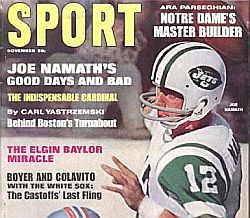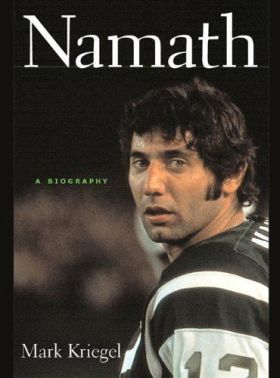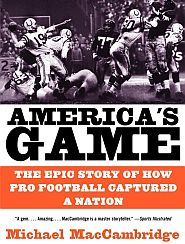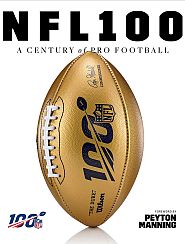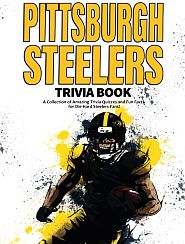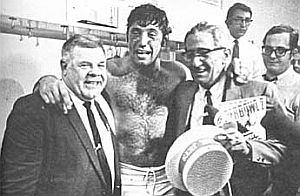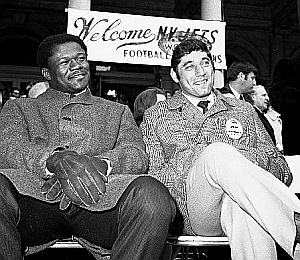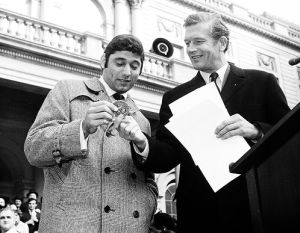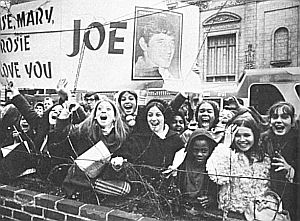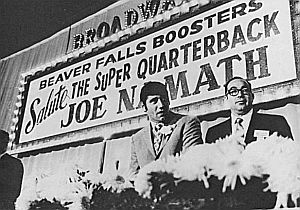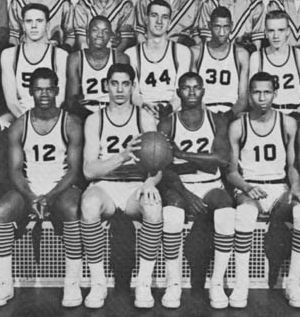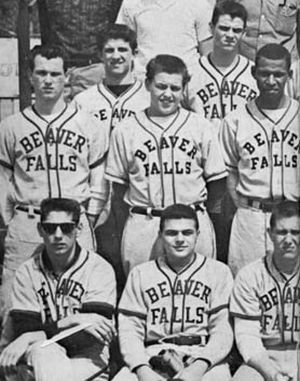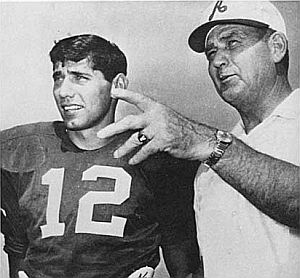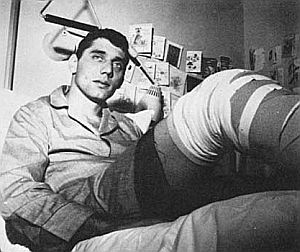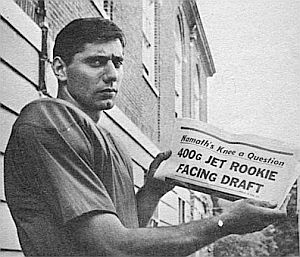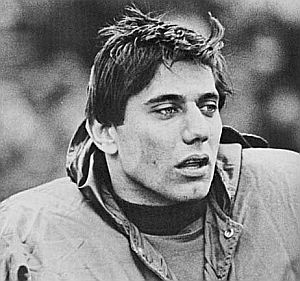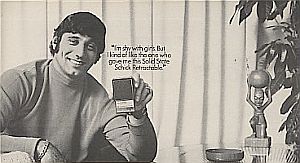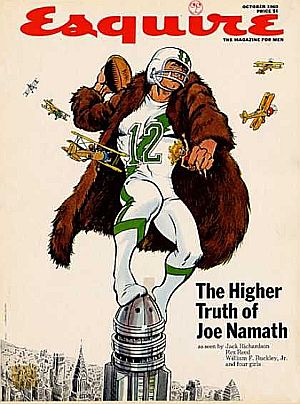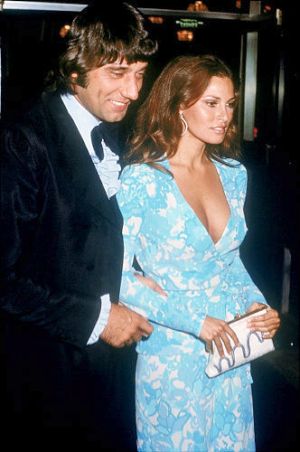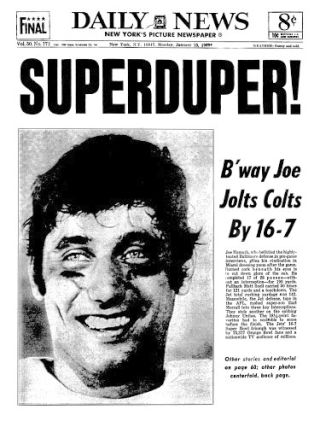
New York "Daily News" headline with Joe Namath photo, January 13, 1969, following the New York Jets’ upset victory over the Baltimore Colts in Super Bowl III.
In 1969, Joe Namath and the Jets were the outsiders in professional football — coming from that “upstart” football league; the American Football League or AFL; a league many regarded as lightweight and in no way the equal of NFL, the National Football League. Only two years earlier, the AFL had begun playing the more established NFL in an annual championship game. The first two of those games– then called championship games, not Super Bowls — were won by the NFL team, the Green Bay Packers. So, by 1969 most fans expected that the champion NFL team, the Baltimore Colts, would likewise dispense with Namath and the AFL’s New York Jets. The odds makers in fact, were betting against the Jets — at first, 7-to-1 against them beating the Colts. By game day the Colts were favored to win by 18-19 points. So the popular banter leading up to the game was that the Jets would be hammered by the Colts. That’s what everybody believed — everybody that is, except Joe Namath. What follows is some back story on Namath and the Jets in the years leading up to 1969, a description of the Jets-vs.-Colts battle in Super Bowl III, and then some accounting of how Namath and this game helped change the tenor of professional football, making it a more valuable business and a more center-stage part of popular culture.
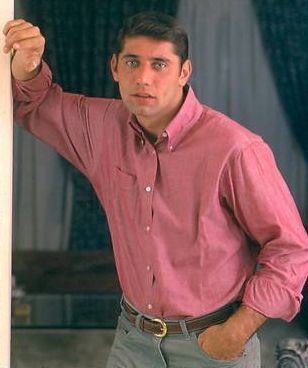
Young Joe Namath, around his rookie year, 1965.
Joe Namath’s grandfather, a Hungarian immigrant, worked in the mines and steel mills around Pittsburgh, Pennsylvania. Joe grew up as the youngest of five children with 3 brothers and 1 sister in a working class Hungarian Catholic family in Beaver Falls, Pennsylvania. Namath’s parents divorced when he was 12 years old, not a happy development for young Joe. Among other things, he was known to frequent local pool halls in his younger years. But Joe Namath also became a standout scholastic athlete, excelling in high school football, basketball and baseball. In basketball, he could dunk the ball in competition, then uncommon in high school (a few high school photos appear below in Sources). He was also a good enough baseball player to receive offers from a number of major league teams, including the Yankees, Mets, Indians, Reds, Pirates, and Phillies. He admired Roberto Clemente of Pirates and at one point thought he might play for Pittsburgh. The Chicago Cubs offered him a bonus of $50,000, but he decided to play football, partly at his mother’s urging him to get a college education. Major colleges sought to recruit him, including Notre Dame, Penn State and others. But in the end he decided to play for Paul “Bear” Bryant at the University of Alabama. Namath led Alabama to a 29-4 record over three seasons, including a National Championship in 1964. However, he would not complete his college degree requirements until years later, in 2007.
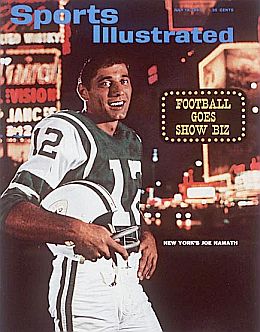
Joe Namath, 'Sports Illustrted,' July 19,1965. Click for similar framed lithograph art by Stephen Holland.
Namath arrived in the pro ranks with something a reputation. At Alabama he had been suspended as a junior when coach Bear Bryant kicked him off the team for drinking and carousing before the last two games of the season. With his good looks and no shortage of female admirers, Namath came off as something of a playboy. And there was a certain star quality about him recognized by others. When Jets owner and former Hollywood executive Sonny Werblin signed the 22 year-old University of Albama star he said: “When Joe Namath walks into a room, you know he’s there. When any other high-priced rookie walks in, he’s just a nice-looking young man.” Werblin also reportedly said to Namath at his signing, “I don’t know whether you’ll play on our team or make a picture for Universal.”

Sonny Werblin knew the value of “star power” in signing Namath.
Werblin came to the Jets knowing well the business value of stars and talent. He would later tell Sports Illustrated: “I believe in the star system. It’s the only way to sell tickets. It’s what you put on stage or the playing field that draws people.” Werblin and partners had purchased the faltering New York franchise in 1963. In the 1965 college draft, Werblin spent $1.1 million to assemble 28 rookies — the most money then ever committed for new athletic talent in one year by any pro football team. Among those acquired was Joe Namath, of course, but also two other quarterbacks, including John Hurate from Notre Dame, the Heisman Trophy winner in 1964, who Werblin also singed for $200,000. Still, it was Namath who got the notice.
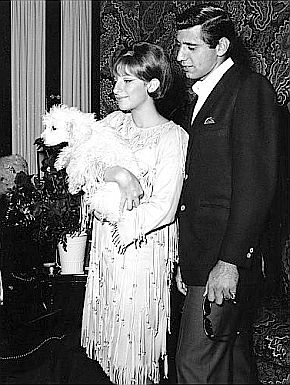
Barbra Streisand, 23, and Joe Namath, 22, backstage at Broadway's Winter Garden, where Streisand was starring in ‘Funny Girl,’ Sept 1965.
1966: 6-6-2
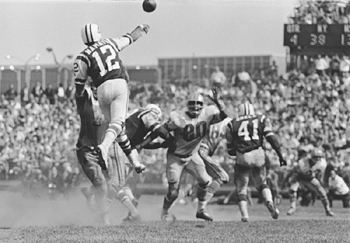
Joe Namath, leaping about 2 feet off the ground, throws a pass over the defensive line of the Houston Oilers at Shea Stadium, Sept. 18,1966. NYTimes/Barton Silverman.
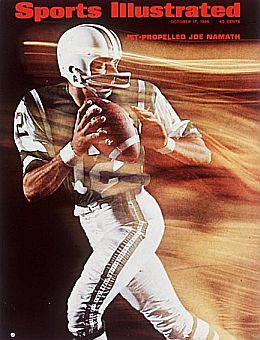
‘Sports Illustrated’ cover story of mid-October 1966 featuring ‘Jet-Propelled Joe Namath.’ Click for copy.
However, as the August 1967 exhibition season got underway, Namath appeared to have a little Alabama undergraduate still in his soul, as he violated the team curfew one night, staying out late. Coach Weeb Ewbank later dealt with his quarterback in private, levying a stiff fine on Namath.
1967: 8-5-1
As the regular season began in 1967, the Jets dropped their opening game on the road to the Buffalo Bills and had a week off until their next game. On September 23rd against the Denver Broncos, Namath was in good form as he passed for 399 yards to help the Jets win, 38-24. The following week, on October 1st, as the Jets’ first home game that season was played at Shea Stadium, a record crowd of 61,240 watched Namath lead his team to win over the Miami Dolphins, 29-7. Namath had a total 415 passing yards that game. Running back Emerson Boozer also scored three touchdowns. The Jets then beat the Oakland Raiders at Shea the following week, and then tied the Houston Oilers the week after that in a game in which Namath made a game-saving tackle on the four yard-line during the closing minutes of play, preventing the Oilers from winning. On October 22nd, the Jets beat the Miami Dolphins, 33-14, after Namath had built a 24-0 first half lead. The following week, a Namath passing touchdown in the fourth quarter gave the Jets a 30-23 win over Boston Patriots. On November 11th, the Jets lost to Kansas City on the road, 42-18. Then back home at Shea Stadium they beat the Buffalo Bills, 20-10 on November 12th. They next traveled to Boston’s Fenway Park where they beat the Patriots 29-24. At the end of November they had a week off, but returned to lose three straight games — to the Denver Broncos, 33-24; the Kansas City Chiefs, 21-7; and Oakland Raiders, 38-29. In their final game of the 1967 season, the Jets beat the San Diego Chargers in San Diego, 42-31.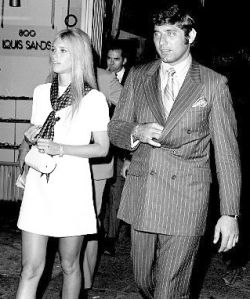
Suzie Storm & Joe Namath, circa 1969.
First At 4,000
The Jets finished that year with an 8-5-1 record. It was their best showing since Namath had joined the team. For his part, Namath had put together a spectacular year. He complied 4,007 passing yards, which made him the first-ever pro quarterback in a 14-game season to pass for 4,000 yards in a season. At the time, passing for 3,000 yards in a single season was considered quite good. By the end of the year, Namath was still making the style pages occasionally, noted for his expensive suits and generally natty dress, sometimes described as the “swinging quarterback of the New York Jets.” One December story in the New York Times featured his bachelor pad — a penthouse apartment with white Llama rug and suede couch. He also continued to get attention as a ladies man. One notable girlfriend he dated in late 1960s was Suzie Storm, a singer and friend since college days and who he was sometimes photographed with during the 1960s.
Super Bowl Season: 11-3
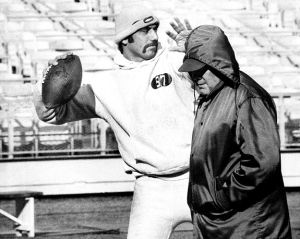
Mustachioed Joe Namath shown at practice in 1968 with Jet’s coach Weeb Ewbank.
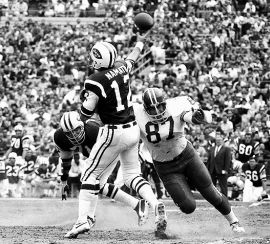
Joe Namath (12), about to take a hit from an oncoming Denver Bronco (87), October 13, 1968, a game in which Namath threw five interceptions.
The game with Oakland, played on November 17, 1968, was also the infamous “Heidi game,” when NBC, believing the game was over with 50 seconds remaining as the Jets then led 32-29, switched from its national broadcast of the game to begin airing the children’s movie, Heidi.
However, in the remaining seconds of the game, Oakland would proceed to score two touchdowns to win the game 43-32, as the Heidi film rolled. Telephone calls from legions of irate viewers overwhelmed NBC switchboard in Manhattan, with much public scorn and ridicule heaped on the network for its televised faux pax. In any case, the Jets would later get another shot at the Oakland Raiders in the championship game. But in the regular season they went on to win their last four games and finished with a record of 11-3.
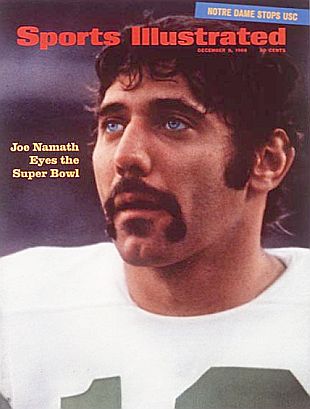
Joe Namath, with mustache, appears on Sports Illustrated cover, Dec. 9, 1968, prior to Super Bowl III. Click for copy.
In the AFL’s championship game, played on December 29, 1968, the Jets faced the Oakland Raiders at Shea Stadium. In what proved to be a very exciting game, Namath led his team to a 27-23 victory, throwing three touchdown passes. With a crowd of 62,627 fans looking on, the Jets took a quick 10-0 lead in the first quarter. By the fourth quarter, they still led 20-13. The Raiders, however, fought back and took a 23-20 lead about midway through the fourth quarter. But the Jets weren’t finished either, as Namath marched them down the field to score with a final short pass to end Don Maynard to re-take the lead, 27-23. The Jets defense then held, and with that, the New York Jets had won the AFL championship. Then it was on to Super Bowl III in January to meet the Baltimore Colts.
Colts on A Roll: 13-1
Over in the NFL, meanwhile, coach Don Shula’s Baltimore Colts had also completed a superior season in 1968 — in fact, pro football’s best that year — finishing the regular season by winning 10 games in a row, four by shutouts. The Colts posted a 13-1 record. In their last ten games, they had allowed only seven touchdowns. Their quarterback, Earl Morrall, who had replaced the legendary Johnny Unitas after an injury, was having a great season, with a league-leading passing performance. On their way to meeting the Jets in the Superbowl, the Colts had decisively beaten the Cleveland Browns 34-0 in the NFL championship game. Given this performance, many regarded the Colts as one of the best teams of all time, even comparable to Vince Lombardi’s championship Green Bay Packer teams — teams that had won Super Bowls I and II. So it was no surprise that the Colts were favored to beat the Jets in the big game.
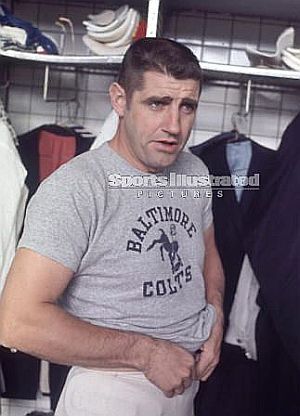
Earl Morrall, quarterback of the Baltimore Colts, had a very good year in 1968. Photo, Sports Illustrated.
Super Bowl III was scheduled to be played in the Orange Bowl at Miami, Florida on Sunday, January 12th, 1969. Both teams had come to Florida a week or so before the game to practice there and become acclimated to the warmer climate and prepare their respective game plans. Joe Namath had been talking to the press about the upcoming game even before his arrival in Florida. In late December, on the 30th, he told the press that Daryle Lamonica of the Oakland Raiders was a better passing quarterback than the Colt’s Earl Morrall. And once in Florida, Namath would appear in public a few more times, also speaking with the press about the game.
On the evening of January 9th, several days before the big game, Namath attended a dinner in the Playhouse Room at the Miami Villas. The Miami Touchdown Club was honoring him as pro football’s most outstanding player for 1968. During the course of events that night, when Namath spoke at one point, someone in the back of the room shouted out “the Colts are going to kick your ass.” Namath then responded: “Hey, I got news for you. We’re going to win Sunday, I’ll guarantee you…” The “guarantee,” as Namath himself would later explain, was not planned or premeditated, it just came naturally in the context of his remarks, prompted in part by the heckler — but also by Namath’s personal belief that the Jets would win. Namath had been studying Colt game films by this time, and he was seeing opportunity in the Colts’ defense. At the dinner, Namath reiterated his views about Colt quarterback Morrall, saying he was entitled to his opinion. He also took issue with press accounts that the Jets defense could not compare to the Colts, giving his own guys very high praise.

Joe Namath, poolside, January 10, 1969, talking with reporters about his prediction that the Jets would beat the Colts in the January 12th Super Bowl. Photo, Walter Iooss Jr./Sports Illustrated.
Namath, meanwhile, persisted with his prediction, defending it poolside with reporters at the Galt Ocean Mile Hotel in Ft.Lauderdale where the Jets were staying. The Colts, he said, were not only beatable, but their quarterback, Earl Morrall, the NFL’s most valuable player, would have a tough time making the Jets’ third string. Engaging with reporters, Namath said: “We’re a better team than Baltimore.” And adding to his critique of Morrall, Namath said, “There are maybe five or six better quarterbacks than Morrall in the AFL.” Sports Illustrated reporter Tex Maule observed that Namath “reminds you a bit of Dean Martin (an actor from the 1950s) in his relaxed confidence and in the droop of his heavy-lidded eyes.” But some in the football world weren’t so taken with Namath.
Namath had already had a personal run-in with Baltimore Colt defensive end and field goal kicker Lou Michaels at a Miami nightclub the previous Monday evening. Michaels and Namath were there seperately having dinner with some teammates. Michaels later sought out Namath at the club telling him what he thought of his off-base remarks about Morrall and the Colts. There was something of a heated exchange between the two, each predicting their side would prevail on Sunday,but no fisticuffs. Namath, in fact, reportedly bought a round of drinks.
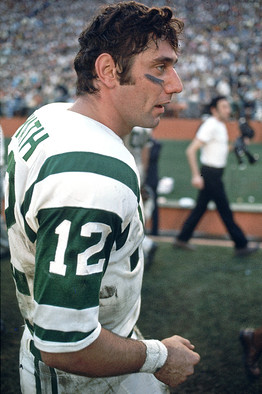
Joe Namath on game day, Super Bowl III, January 12, 1969. Click for Namath/Super Bowl III plaque w/stats.
Most football fans, meanwhile, were unaware of Namath’s prediction that the Jets would win. This was the era before “all news all the time” — i.e., 1969 B.C., or “before cable.” This was a world without the internet, the iPhone, Twitter, etc.,. Newspapers and three-channel broadcast TV were the primary media. There were no TV cameras present at the banquet when Namath had made his remarks. The only news coverage of Namath’s “guarantee” was that first carried by Miami Herald newspaper on Friday, January 10th. On the Saturday before the game, January 11th, one New York paper, Newsday, had picked up the story. But most papers in Manhattan didn’t have it until game day, and even then it didn’t get much notice. At the outset of the game’s TV broadcast on game day, NBC’s announcer Curt Gowdy did say something about Namath’s prediction. Still, around the country, old-school fans who had heard about Namath’s prediction thought it little more than big-mouth braggadocio, and that Namath would get his comeuppance in the game. And so, it really wasn’t until after the game had ended that Namath’s famous prediction would begin to enter the realm of legend.
The Game
As the game began, it looked like the Baltimore Colts were going to validate the bookies’ odds-making prediction of a Colts blow-out over the Jets. The Jets had won the opening kickoff, but had five plays before turning the ball over to Baltimore.Then the Colts’ Earl Morrall went to work. He first passed to tight end John Mackey who ran over two Jet tacklers for 19 yards. Then fullback Tom Matte swept right end for 10 yards. Running back Jerry Hill then swept left for seven more yards. The first downs were racking up. Then Morrall passed to tight end Tom Mitchell for 19 more yards, another first down.
The Jet defense then began to find itself and tightened up, forcing two incomplete passes. Morrall then sought to pass again on third down, but found no open receivers so he ran for no gain. The Colts kicker, Lou Michaels, then tried a field goal from the 27-yard line, but missed. On the Jets’ second possession in the first quarter, Namath threw deep to end Don Maynard, who was open by a step, but the ball was overthrown. After one quarter of play the Jets had held the powerful Colts to a stale mate. The score was 0-0.
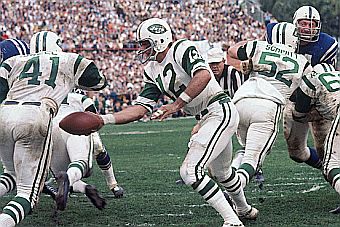
Jan 1969, Super Bowl III, Joe Namath hands off to fullback Matt Snell as Jet lineman clear the way. Click for LeRoy Neiman art print.

Baltimore Colts’ defensive lineman, Buba Smith (78), makes a charge at Joe Namath in Super Bowl III. Click for copy.
Superbowl III marked the first time that celebrities appeared in various game related ceremonies. Bob Hope led a pregame ceremony honoring Apollo 8 astronauts for the first manned flight around the Moon. Singer Anita Bryant sang the national anthem at the game. Big-time rock stars at halftime, however, had not yet arrived. The Florida A&M University band did the halftime show. On the first play of the second half, the Jets recovered a Tom Matte fumble which led to the Jets’ Jim Turner kicking a 32-yard field goal to make the score 10-0, Jets. Baltimore on its next possession lost the ball on downs. Namath then took his team back down the field with a series of passes, setting up another Turner field goal, this time from 30 yards out. It was now 13-0, Jets.
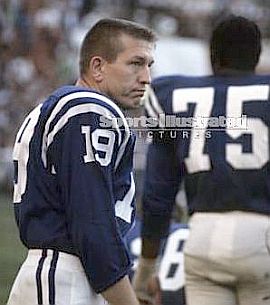
The Colts turned to Johnny Unitas late in Super Bowl III. Sports Illustrated photo. Click for his book.
The Colts were then successful with an onside kick, recovering the ball on the Jet 44 yard line. With 3:14 to go, Unitas hit three passes in a row, but then he missed three and lost the ball on downs. Taking over with 2:21 remaining in the final quarter, Namath used his running back Matt Snell on six running plays to eat up the clock. In fact, the Jets would not run a single pass play the entire fourth quarter. But in this final series, the Jets could not get another first down. Namath then took two penalties for delaying the game to wind down the clock down further. Jets punter Curley Johnson then kicked the ball to the Colts with only 15 seconds remaining. Unitas came back in to try to do the impossible, and he managed to complete one of two passes, but time ran out.

NYJets coach Weeb Ewbank congratulates Joe Namath in the closing seconds of the Jets’ 16-7 Super Bowl III victory in Miami, Jan. 12, 1969. AP photo.
Joe Namath, meanwhile, won the Super Bowl MVP award, more for his masterful game management than passing skills. Namath, in fact, did not throw a scoring touchdown all day, though he did use his passing talents strategically, completing 17 out of 28 passes for 206 yards and no interceptions. And it wasn’t just Joe Namath, of course.
First and foremost was the hard running display of fullback Matt Snell, amassing 121 yards in 30 carries. Split end George Sauer had snagged eight completions from Namath for 133 yards.
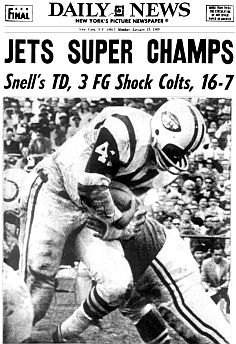 NY Daily News cover featuring Matt Snell, whose running was key to Jets' Super Bowl III victory. |
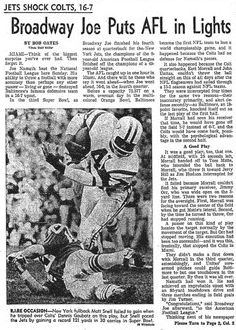 Part of the L.A. Times’ coverage lauding Namath & Jets for their Super Bowl III win, 13 Jan 1969. |
Defensively, the Jets’s secondary had a good day, picking off four Baltimore passes. Randy Beverly had two of those. The Jets offensive line had cleared the way for Snell and kept Namath well protected. Jet lineman Dave Herman had a tough assignment in the Colt’s hard-charging Buba Smith, but he kept Smith at bay.
On the other side, Baltimore had a pretty bad day, with fumbles, interceptions and missed field goals proving costly. Morrall was 6 of 17 for 71 yards and was intercepted three times. Lou Michaels had missed two field goals. The Jets, for their part, had also missed scoring opportunities.
For the Colts, however, there were a few bright spots. Unitas in his brief appearance had 11 completions for 110 yards, but was also intercepted once. Tom Matte had 116 yards on 11 carries and also caught 2 passes for 30 yards. Actually, with the exception of the turnovers, the game statistics for the two teams overall were very close in just about every category.
Overall, though, it was Namath’s day, as he was praised for running an intelligent game; one that included changing plays at the line of scrimmage, reading defenses incisively, and dealing with Baltimore’s famed defensive blitz. “Namath’s quickness took away our blitz,” said Colt coach Don Shula after the game. “He beat our blitz more than we beat him.”
Namath’s teammates also had high praise for their quarterback, especially for his positivism before and during the game. “He never let up all game,” said Jet rookie John Dockery, a Harvard grad. “Every time he’d come to the sidelines after a series he’d pat everybody and keep telling us, ‘c’mon, c’mon — today is our day'”
Around the country the next day, the headlines in major newspapers reported surprise at the upset, with a few vindicating Namath’s predictions about game and the worth of the AFL. “Jets Shock Colts in Super Bowl,” reported the Washington Post. “Namath Stands Behind Guarantee in 16-7 Jet Victory,” ran one headline with an Associated Press story.
“Broadway Joe Puts AFL in Lights,” said the Los Angeles Times, headlining one of its stories that suggested the AFL had now arrived. “Broadway Joe Rings Down the Curtain on the NFL,” was the headline used on the continuation page of that same story.
Some L.A.Times columnists weighed in on the AFL vs. NFL argument. A Jim Murray story was headlined: “Don’t Look Now…But that Funny Little League is No.1.” A Bob Oates story was more circumspect: “Namath No.1, But NFL Teams Still Tougher.” Another headline spread across two pages in one paper read: “Famed Colt Defense Was Picked to Pieces…By Broadway Joe, Ruler of the Jet Set.” And so it went, all around the country. Many big city papers in NFL towns that had predicted a Colts victory, or that Namath would be crushed, were now eating crow.
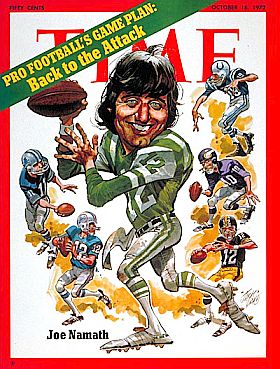
Joe Namath caricature on Time cover, October 1972 in story about growing interest in pro football. Click for copy.
New Era
Pop Sports Biz
But Joe Namath and Super Bowl III also marked a change in the history of sports in mainstream culture. Football in particular became more of a “pop sports businesses.” Following this game, sport as big-business entertainment, sports news, and sports broadcasting were all ratcheted up another notch. Sports hype, sports promotion, and sports coverage all increased.
Pro football, in particular — the sport and its stars — all got a little bigger and moved more center stage in popular culture. Monday Night Football first aired on ABC-TV on September 21, 1970 featuring a game between the New York Jets and the Cleveland Browns (at Cleveland’s Municipal Stadium where a record 85,700 fans came out). Advertisers were charged $65,000 per minute for that game by ABC, but its telecast collected a 33 percent share of the viewing audience. Pro football became a lot more important in terms of bottom-line business value — for owners, the media, and advertising. By mid-October 1972, with Joe Namath on its cover, Time magazine noted the following about Namath and the game:
…Win or lose, Namath generates more high-voltage excitement than any other player in the game. Indeed he is the sort of thrill producer that the N.F.L. badly needs these days. On the surface…the game still appears to be prospering at the brisk pace it set in the 1960s. Baseball may be the national pastime, but pro football has become the national obsession. It is now, according to N.F.L. Commissioner Alvin (“Pete”) Rozelle, a $130 million-a-year business. There are 26 teams in the league’s two conferences, and Rozelle talks of expanding… Last year the N.F.L.’s regular-season attendance surpassed ten million for the first time. Psychologists and sociologists by the score are peering into homes to determine the familial side effects on the 30 million-plus Americans who sit glazed before the tube on Sunday afternoons and Monday nights.
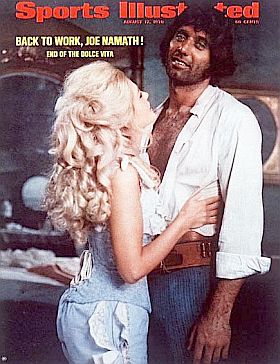
Joe Namath and actress Ann Margaret on movie set of 'C.C. and Company', Sports Illustrated, Aug 17, 1970. During off season and after he left football, Namath ventured into film & TV.
And Namath’s stardom and stature were such that he began to cross over into the regular entertainment world. In fact, he is sometimes cited as one of the first “multi-platform” big time athletes — starring in advertisements, film, books, and television. Following Super Bowl III, for example, in 1969 alone, he: published a book, I Can’t Wait Until Tomorrow (co-written with sports writer, Dick Schaap); launched The Joe Namath TV Show of sports talk and related guests, co-hosted with Dick Schapp; appeared in TV and print advertising; and also began taking film roles in Hollywood and for television. But in the end, for Joe Namath, it has been the sports moment of January 12, 1969 that has lived in time.
The Iconic Moment
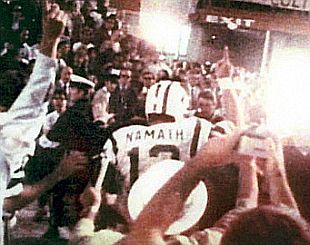
Joe Namath leaving the field of victory following Super Bowl III, January 12, 1969, index finger aloft signifying, "We're No. 1".
Or as Mike Lupica of the New York Daily News put it in a 40-years-later piece: “Nobody ever proved that [Babe] Ruth actually called his [home run] shot in that World Series against the Cubs. Namath called his.” In Joe Namath’s athletic career, and much of his public life as well, there was perhaps no better moment than winning Super Bowl III.
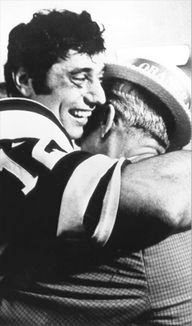
Joe Namath embraces his Dad, John Namath, at end of Super Bowl III, who he credits with giving him confidence in sport as a young boy.
Joe Namath would play eight more seasons with the Jets, finishing his career in 1977 with a final season with the Los Angeles Rams. Plagued with knee injuries and a series of surgeries throughout much of his career, and playing at a time when quarterbacks were not protected by game rules, Namath still managed to complete 1,886 passes for 27,663 yards and 173 touchdowns. He played in four AFL All-Star games and one AFC-NFC Pro Bowl.
Joe Namath was inducted into the Pro Football Hall of Fame in 1985, and a number of well-respected coaches have touted his abilities. Bill Walsh, long-time coach of the San Francisco 49ers and three-time Super Bowl victor, has said that Namath was “the most beautiful, accurate, stylish passer with the quickest release I’ve ever seen.” And Don Shula called him “one of the 3 smartest quarterbacks of all time.”
Meanwhile, Joe Namath, the famous bachelor, did marry and became a family man. In 1984, when he married Deborah Mays, an aspiring actress, he settled down, stopped drinking, and became a devoted father of two daughters. Fifteen years later, however, in 1999, that marriage ended. Today Namath remains close to his now grown daughters, and one grandchild, who live with him in Florida.
The Real Namath
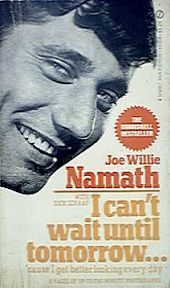
Joe Namath’s 1969 book, with Dick Schaap, might have left the wrong impression for some. Click for copy.
And for all the hype about his boasting — even in his prime New York Jets days — Namath was a guy who was privately not what he may have appeared to be in public. Hank Stram, coach of the Kansas City Chiefs remarked in 1975: “Too many people have given him the Broadway Joe image. He’s not that way at all.” Namath’s playboy image was hyped up as well, said Phil Iselin in July 1975, then president of the Jets organization. “He’s not that way at all,” said Iselin. “He is actually a very quiet and timid guy. I think more people are getting to know the real Joe Namath.”
Iselin did admit to Namath being the “greatest sports attraction since Babe Ruth,” adding that the Jets had then, by July 1975, already sold out its 1975 fall season, with a long waiting list. “You can give Joe a lot of credit for that.”
Sportswriter and commentator, Dick Schaap, co-authored and helped Namath write his 1969 book, I Can’t Wait Till Tomorrow..Because I Get Better Looking Every Day, which, according to Schaap, was part put on. Still, Schaap worried that some folks might get the wrong impression from this book and think Namath was “a braggart”. Schaap explained, in fact, that Namath was the opposite of a braggart, though he had a sense of humor and was a guy who “winked at life”. Schaap noted that in the process of reviewing the manuscript for the book, Namath “deliberately edited out anything that smacked of serious immodesty, anything that sounded to him as though he were placing himself on a pedestal.” Schaap also added that while Namath was “no saint,” and that he could be rude and ill tempered at times, there were other aspects of Namath’s personality and character that did not appear in the book or always surface in public — “like his honesty, his generosity, his loyalty to old friends, his respect for elders, and of course, his charm with men and women.” Even when Namath made his much-celebrated “guarantee” he was making it out of a belief in himself and his teammates; a confidence he credits his father with instilling in him during his boyhood. As Namath’s high school football coach Larry Bruno said of Namath at his 1985 Hall of Fame induction: “When Joe played football for Beaver Falls High School, the entire football team believed whatever play Joe called it would work; they would make it work because they knew Joe had confidence in them.”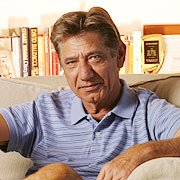
Joe Namath, ‘USA Today’ photo, October 2004.
Namath, mortified and contrite, later apologized to Kolber and has admitted to being “way out of line;” that it was “awful, rude behavior.” But the incident served to get Namath into rehab and onto a more sober path. According to his agent Jimmy Walsh: “That probably turned out to be one of the best things that ever happened to Joe. He said, ‘Wait a second. I better straighten myself out.’ And he did.”
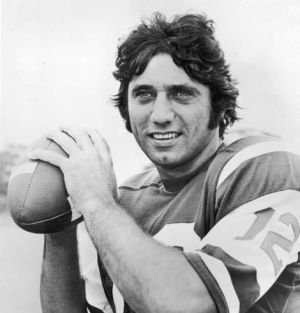
Joe Namath, working at his day job, 1970.
Additional football-related stories at this website include: “Big Game, New Era: Colts vs. Giants, 1958”(about famous NFL Championship game that some have called one of the greatest ever played, and also a pivot point for big-time pro football); “Dutchman’s Big Day”(about the single-game passing record set in 1951 by Norm Van Brocklin and his other championship play with the L.A. Rams & Philadelphia Eagles); “Bednarik-Gifford Lore” (the respective playing careers of Chuck Bednarik and Frank Gifford, and one famous on–the-field meeting between the two); “Slingin` Sammy” (career of quarterback Sammy Baugh and Washington Redskins history, 1930s-1950s); and “Celebrity Gifford” (detailed look at the advertising, TV/film, and sports broadcasting career of Frank Gifford). See also the Annals of Sport category page for other sports stories.
Thanks for visiting – and if you like what you find here, please help support the research and writing at this website by making a donation. Thank you – Jack Doyle
|
Please Support Thank You |
_______________________________
Date Posted: 23 December 2009
Last Update: 11 February 2024
Comments to: jackdoyle47@gmail.com
Article Citation:
Jack Doyle, “I Guarantee It. Joe Namath,”
PopHistoryDig.com, December 23, 2009.
________________________________
Football Books at Amazon.com…
Sources, Links & Additional Information
Allison Danzig, “No. 1 Team Halted on One-Foot Line; Koy Scores Twice, Once on 79-Yard Dash — Namath Is Brilliant in Defeat” (Orange Bowl, college game), New York Times, Saturday, January 2, 1965, p.13.
Allison Danzig, “Namath Accepts a $400,000 Pact to Play for Jets; Contract Reported to Be for 3 Years — Huarte Seen Ready to Join Club,” New York Times, Sunday, January 3, 1965, p. S-1.
“‘Bama Star Gets $400,000; Namath Pro Football’s Richest Rookie,” Los Angeles Times, January 3, 1965, p. D-1.
“Ewbank of Jets Says His Scouts Call Namath ‘Best Since [Sammy] Baugh’,” New York Times, Sunday January 3, 1965, p. S-3. (See also, Jack Doyle, “Slingin’ Sammy, 1930s-1950s,” PopHis- toryDig.com).
Sid Ziff, “Namath Hot Copy,” Los Angeles Times, January 5, 1965, p. C-3.
United Press International (UPI), “Namath’s Pay Inflates Ryan’s Sense of Values; Browns’ Quarterback Asserts He Should Get $1 Million Believes a Tested Star Rates That Over $400,000 Rookie,” New York Times, Tuesday, January 5, 1965, p. 27.
“Namath Deal Irks Ryan, Jurgensen,” Washington Post, Times Herald, January 5, 1965, p. B-2.
“Pro Football: The Collectors,” Time, Friday, January 15, 1965.
UPI, “Namath Kisses Stewardess on Return to ‘Bama,” Washington Post, Times Herald, February 7, 1965, p. C-1.
William N. Wallace, “Ticket Sales up for Giants, Jets; Signing of Namath, Other Top Talent Cited as Reason,” New York Times, Wednesday, February 10, 1965, p. 37.
UPI, “Hometown Fetes Namath,” Washington Post, Times Herald, February 27, 1965, p. D-4.
Robert H. Boyle, “Show-Biz Sonny and His Quest For Stars,” Sports Illustrated, July 19, 1965.
“People,” Time, September 24, 1965.
“Joe Namath,” Wikipedia.com.
Dave Brady, “Otto Graham In Middle Over Namath,” Washington Post, Times Herald, March 30, 1965, p. C-3.
William N. Wallace, “Namath Passes for Two Scores in Debut as Jets Beat Patriots, 23-6; Rookie Connects on 9 of 19 in Air…,” New York Times, Thursday, July 29, 1965, p. 23.
William N. Wallace, “Football Scores Over Show Biz; Namath and Huarte Benched in Favor of Taliaferro,” New York Times, Saturday, September 4, 1965.
Frank Litsky, “Taliaferro Gets Jet Starting Job; Namath to Be Back-Up Man Against Chargers Tonight,”New York Times, Saturday, October 23, 1965.
Frank Litsky, “Namath Passes For 2 Scores as Jets Top Patriots, 30-20, for Third in Row,” New York Times, Monday, November 15, 1965, p. 53.
“Namath Zings 4 TD Passes as Jets Romp,” Los Angeles Times, November 22, 1965, p. B-5.
Dave Brady, “1-Y, 4-F or 1-D, Selective Service Can’t Touch Clay, Namath, Nobis,”Washington Post, Times Herald, January 9, 1966, p. C-4.
Dick Young, “Oiler Accused in ‘Cheap Shot’ Namath Injury,”Los Angeles Times, August 16, 1966, p. B-2.
Frank Litsky, “Namath Throws Five Touchdown Passes as Jets Turn Back Oilers, 52 to 13; 54,681 Fans Set Mark for League; Namath’s Tosses Gain 283 Yards–New York Breaks Team Scoring Record,” New York Times, Monday, September 19, 1966, Sports, p. 58.
Frank Litsky, “Jets’ Second-Half Rally Beats Broncos, 16-7; Eagles Rout Giants, 35-17; Namath Connects in Final Quarter, Snell Takes 5-Yard Scoring Pass–Jim Turner Kicks Three Field Goals,” New York Times, Monday, September 26, 1966, p. 52.
Frank Litsky, “Namath’s Passes Ward Off Defeat; 14 Completed in 4th Period for 205 Yards Turner’s Field Goal Ties Score,” New York Times, Monday, October 3, 1966, Sports, p. 85.
Frank Litsky, “Namath Checked in Houston Game; 4 Interceptions Mark First Defeat for Jets–Blanda Passes for 2 Scores,” New York Times, Monday, October 17, 1966, Sports, p. 50.
Dan Jenkins, “The Sweet Life Of Swinging Joe,” Sports Illustrated, October 17, 1966.
Dave Anderson, “Bills’ Defense Enjoys Namath Pool; Player Who Gets to Passer Most Often Wins Side Bets,” New York Times, Monday, October 31, 1966, Sports, p.62.
Frank Litsky, “5 Namath Passes Are Intercepted; Jets Throw 53 Times, Bills 40; Warner Scores on a 95-Yard Kickoff Return,” New York Times, Monday, October 31, 1966, Sports, p. 62.
Dave Anderson, “2-point Play Key; Namath Hits on Pass for Conversion after Boozer Scores; Raiders Strike Quickly; Jets and Raiders Play a 28-28 Tie,” New York Times, Sunday, December 4, 1966, Sports, p. S-1.
Charles Maher, “Joe Namath: The League Leader—in Publicity,” Los Angeles Times, December 12, 1966, p. C-1.
Frank Litsky, “Namath Excels; Throws 3 Touchdown Passes–Boozer, Snell Also Star,” New York Times, Sunday, December 18, 1966, Sports, p. S-1.
William N. Wallace,”Victory Is Tied to Namath’s Maturity,” New York Times, Sunday, December 18, 1966, Sports, p. S-3.
Frank Litsky, “Namath of Jets Undergoes Surgery to Remove Torn Cartilage in Right Knee; Operation Here Termed a Success Tendon Also Is Transferred to Kneecap to Provide Greater Stability,” New York Times, Thursday, December 29, 1966, Sports, p. 37.
William N. Wallace, “Namath’s Mobility Raises Jets’ Title Hopes; Knee Problem Eased As Passer Practices Without Limping,” New York Times, July 25, 1967.
Frank Litsky, “New Yorkers Win Exhibition, 55-13; Namath Reported to Violate Curfew, Plays a Period– Boozer Scores 3 Times,” New York Times, Saturday, August 5, 1967, Sports, p. S-17.
“Night on Town Proves Costly to Joe Namath,”Los Angeles Times, August 6, 1967, p. G-7.
Frank Litsky, “Jets’ Ace to Explain Reported ‘Night on the Town’; Ewbank to Rule on Namath’s Thursday Fling,” New York Times, Sunday, August 6, 1967, Sports, p. 155.
Frank Litsky, “Jets Trounce Dolphins, 29-7, Before 61,240, a Record; 415 Yards Gained in Air by Namath Boozer Scores 3 Times as Jets Take Eastern Lead in Opening Home Game,” New York Times, Monday, October 2, 1967, Sports, p. 64.
William N. Wallace, “Namath of Jets Passes Rivals As A.F.L.’s Top Quarterback,” New York Times, Tuesday, October 3, 1967, Sports, p. 58.
“Namath, Tarkenton Excite N.Y. Football Fans,” Los Angeles Times, November 16, 1967, p. C-8.
Judy Klemesrud, Edward Hausner, and Larry Morris, “The Penthouse of Joe Namath: First There’s the Llama Rug…; Suede Couches Appeals ‘To Me’,” New York Times, Tuesday, December 12, 1967, Family/Style, p. 54.
“Jets Romp Past Chargers, 42-31, as Namath Sets Passing Record,” Los Angeles Times, December 25, 1967, p. C-2.
“Joe Namath’s Left Leg in Cast,” Los Angeles Times, January 26, 1968, p. B-7.
Bob Oates, “Namath’s Year? Stram Says ‘No’,” Los Angeles Times, September 14, 1968, p. A-2.
Bob Oates, “Gotham Glamor Guys; Namath, Tarkenton Invade Golden State,” Los Angeles Times, November 17, 1968, p. D-13.
“NBC Reverses Field After Namath Is Dumped for Showing of Heidi,” Los Angeles Times, November 19, 1968, p. C-2.
Charles Maher, “Namath Doesn’t Even Muss His Mustache in Rout of Chargers,” Los Angeles Times, November 25, 1968, p. B-1.
“Jets’ Star Shaves Controversial Mustache; Namath Takes It Off for $10,000,” Washington Post, Times Herald, December 12, 1968, p. K-1.
Dave Anderson, “Namath Takes It Off — at $10 a Clip,” New York Times, Thursday, December 12, 1968, p. 68.
“Namath Heads Chain Of Fla. Cafes,” Washington Post, Times Herald, December 14, 1968, p. D-5.
“People,” Time, (re: Namath Schick razor ad), Friday, December 20, 1968.
“Reporters and Coaches Agree: Namath No. 1 Player in A.F.L,” New York Times, Wednesday, December 25, 1968, p. 47.
Dave Anderson, “Jets Favored over Raiders; Raiders Wary of Namath Arm,” New York Times, Sunday, December 29, 1968, p. S-1.
Dave Anderson, “Jets Win A.F.L. Title by Defeating Raiders, 27-23, Before 62,627 Here; Namath Connects for 3 Touchdowns; Maynard Registers Twice — Jets to Face Colts in Super Bowl Jan. 12,” New York Times, Monday, December 30, 1968. p.40.
Jeff Prugh, “It’s Super Joe vs. Super Colt Defense,” Los Angeles Times, December 30, 1968, p. D-1.
Bob Oates, “Namath to Test Colt Zone Defense,” Los Angeles Times, December 31, 1968, p. D-2.
“Namath Delivers First Super Bowl Salvo; Rates Lamonica as a Better Passer Than Morrall,” New York Times, Tuesday, December 31, 1968, p. 35.
Joe Willie Namath, I Can’t Wait Until Tomorrow … ‘Cause I Get Better Looking Every Day by (Hardcover – January 1, 1969).
“Colts By 18,” Daily News, January 4, 1969.
Luther Evans, “I Guarantee We’ll Win — Namath,” Miami Herald, January 10, 1969.
Dave Brady, “Shula Refutes Namath’s Charge NFL Pass Figures Are Padded,” Washington Post, Times Herald, January 10, 1969, p. D-1.
Norm Miller, “Colts on Joe: Good Passer, No Humility,” Daily News, January 10, 1969.
Luther Evans, “Is Namath’s Lip Action Kiss of Death for The Jets?,” Miami Herald, January 11, 1969.
George Usher, “Can The Jets Win? Joe Guarantees It,” Newsday, Januaury 11, 1969.
Bob Oates, “Namath’s Super Confidence Shakes Crowd,” Los Angeles Times, January 11, 1969, p. E-5.
Dick Young, “Super Bowl is Born,”Daily News, Friday, January 11, 1969.
“Rookie Says, ‘Namath Made Us All Believe’,” Los Angeles Times, January 13, 1969, p. F-2.
Dave Brady, “Jets Shock Colts in Super Bowl, 16-7,” Washington Post, Times Herald, January 13, 1969, p. C-1.
Los Angeles Times coverage of Jets vs. Colts Super Bowl, January 1969.
Bob Oates, “Namath No.1, But NFL Teams Still Tougher,” Los Angeles Times, January 14, 1969, p. F-1.
“Namath Offered Role in Movie,” Washington Post, Times Herald, January 14, 1969, p. D-1.
Tex Maule, “Say It’s So, Joe,” Sports Illustrated, January 20, 1969.
“Bedlam on Broadway; Screaming Girls Mob Namath in New York,” Los Angeles Times, January 23, 1969, p. E-6.
“Schoolgirl Squeals Cap Namath’s Day; …Telegram From Governor; 5,000 at City Hall,” Washington Post, Times Herald, January 23, 1969, p. F-3.
“Impossible Reality,” Time, Friday, January 24, 1969.
“Namath Captures Hickok,” Washington Post, Times Herald, February 4, 1969, p. B-3.
“Namath, McLain, Morrall Finalists in Pro Balloting,” Los Angeles Times, February 16, 1969, p. C-11.
Bob Oates, “Joe Namath Another Baugh? Sammy Says Yes,” Los Angeles Times, February 25, 1969, p. E-1. (See also, Jack Doyle, “Slingin’ Sammy, 1930s-1950s,” Pop HistoryDig.com).
“Joe Namath and the Jet-Propelled Offense,” Time, Monday, October 16, 1972.
“Namath: The Juicy Rewards of a Painful Life” (Joe Namath, Life magazine cover story, with photos by Harry Benson), Life, November 3, 1972, pp. 36-42.
Dick Schaap, “‘I Still Do What I Want To Do – Only I Don’t Want To Do As Much’,” Life, November 3, 1972, pp, 46-49.
Harry Benson, Cover Story, “Quarterback Shuffle: The Ecstasy of Being New York Jets Quarterback Joe Namath-and the Agony of Having His Knees,” People, September 16, 1974, p. 6.
Will Grimsley, Associated Press, “Jet Considered Charisma in Namath Contract Terms,” The Free Lance-Star (Freder-icksburg, VA) July 31, 1975, p. 7
Grace Rishell, “Meet The Woman Who Married Joe Namath,” Pittsburgh-Post Gazette, Monday January 28, 1985, p. 9.
Joe Namath Hall of Fame Speech, with Introduction by Beaver Falls High School Coach, Larry Bruno, @ CBSsports .com.1985.
Robert McG. Thomas, Jr., “Sonny Werblin, an Impresario of New York’s Sports Extravaganza, Is Dead at 81,” New York Times, November 23, 1991.
Jack Newfield, “Namath Biography a Feat,” The Sun (New York), August 13, 2004.
Jon Saraceno, “‘Broadway Joe’ Puts Life Back on Track,” USA Today, October 14, 2004.
Stephen Barbara, “The Football Legacy Of Joe Namath,” The Weekly Standard, @ CBSNews.com, November 20, 2004.
Les Carpenter, “Nothing Like Namath’s Guarantee — QB Made History With Correct Prediction That Jets Would Beat Heavily Favored Colts in Super Bowl III,” Washington Post, Tuesday, January 30, 2007, p. E-5.
Greg Bishop, “40 Years Later, Old Jets Relive Super Bowl III,” New York Times, September 4, 2008.
“TJB Hall of Fame: Joe Namath,” TheJets Blog.com, July 14th, 2008.
“Joe Debuts on Broadway,” Photo Gallery, Daily News, October 25, 2008.
“Joe Namath, Ladies Man,” Photo Gallery, Daily News, October 25, 2008.
Allen Barra, “This Bowl Made Them Super: What’s Remembered About ’69 — And What’s Forgotten,” Wall Street Journal, January 31, 2009, p. W-9.
Mike Lupica, “Forty Years Later, Joe Namath’s Still Super,” Daily News, Sunday, February 1, 2009.
Mark Kriegel, Namath, A Biography, New York: Viking, August, 2004, 528 pp.
Larry Borstein, SuperJoe: The Joe Namath Story, Tempo Books, 1969.
Robert B. Jackson, Joe Namath, Superstar, January 1, 1968.
Joe Millard, The Last Rebel, Mass Market Paperback, 1970.
James T. Olsen Joe Namath: The King of Football, January 1974.
Jim Burke, Joe Willie, The Story of Joe Namath, Paperback, 1975.
“Jets: Broadway’s 30-Year Guarantee,” New York Daily News, Legends Series, New York: Sports Publishing LLC, December 1998, 200 pp.
Beverly Keel, “Interview With Joe Namath,” AmericanProfile.com, Publish- ing Group of America, Inc., January 23, 2005.
Joe Namath, Namath, New York: Rugged Land Books, 2006, 320 pp., 200 photos & DVD.
Michael Oriard, Brand NFL: Making and Selling America’s Favorite Sport, UNC Press, 2007, 326pp.
Andy Martino, “Jets Beat Baltimore Colts in Super Bowl III, Change NFL History,” Daily News, Sunday, October 26, 2008.
Colin S. Stephenson, “Izenberg: Who Could Have Believed That Crazy Joe Namath Would Be Right?,” Star-Ledger @NJ.com, January 26, 2009, with video of Izenberg remembering Super Bowl III and Namath at poolside.
Ed Gruver, From Baltimore to Broadway: Joe, the Jets, and the Super Bowl III Guarantee, Triumph Books, hardcover, September 2009, 256 pp.
A Joe Namath website @ CBSsports.com.
BroadwayJoe.org (extensive photos).
Dave Anderson, Countdown to Super Bowl (1969), Random House, 247pp.
Lou Sahadi, The Long Pass: The Inside Story of the New York Jets from the Terrible Titans to Broadway Joe Namath and the Championship of 1968 (1969 paperback), Bantam Books, 234pp.
Joe Willie Namath, Joe Namath: A Matter of Style (1973), Little Brown, 196pp.
Rose Namath Szolnoki, Namath: My Son Joe (1975), Oxmoor Houser, 189pp.
Jeff Miller, Going Long: The Wild Ten Year Saga of the Renegade American Football League in the Words of Those Who Lived It (2004), McGraw-Hill, 416pp.
___________________________________
